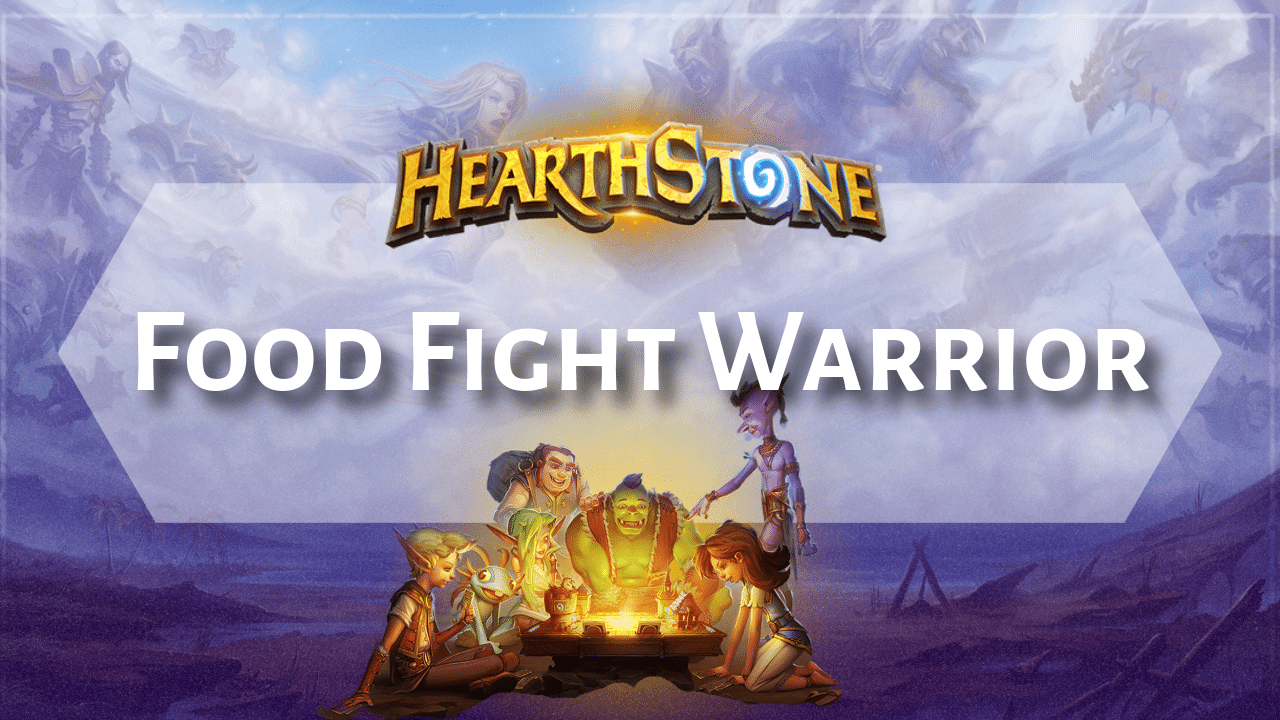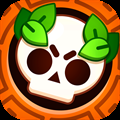
Hearthstone Food Fight Warrior Introduction
The Hearthstone Food Fight Warrior archetype is a recent innovation in Hearthstone, built around exploiting the Warrior spell Food Fight to gain early board dominance by summoning powerful minions from the deck. At the heart of this strategy is Food Fight, a three-mana spell that gives your opponent a 0/4 Entree minion with a deathrattle: “When this dies, summon a random minion from your deck.”
The key to the deck’s success lies in the Warrior’s ability to quickly destroy this Entree, thereby triggering the deathrattle and summoning one of their own high-cost threats significantly earlier than usual. The primary goal of the deck is to cheat out massive minions like Brier Spawn Drake, a 10-mana 12/7 dragon, as early as turn four or even turn three with the Coin. This rapid tempo swing forces opponents to respond with removal or unfavorable trades, often pushing them off their game plan.
Hearthstone Food Fight Warrior has several variants that adapt to different strategies and budgets. Some lists are budget-conscious, making the archetype more accessible while still maintaining its core synergy. Others focus entirely on maximizing the impact of Brier Spawn Drake, pairing it with Cloaked Corruption to create multiple copies and overwhelm the board.
In more aggressive environments, certain builds include Starship cards to apply early pressure, offering an alternative path to victory if the primary dragon plan falters. A less common but notable variation includes the use of Rivendare, aiming for a one-turn kill combo setup, adding a surprise factor to the deck’s win conditions.
There are also “Recruit Warrior” lists that combine Food Fight with other recruit-style tools like Chemical Spill, enabling the summoning of a diverse range of large minions, including not just dragons, but also powerful beasts and other high-impact threats. Cards such as Draconic Delicacy, Tortolla, and Ysondre are typical inclusions in these builds, reinforcing the “Big Minion Recruit” strategy and giving the deck flexibility and resilience in various matchups.
Key Cards and Synergies
The core of the Hearthstone Food Fight Warrior deck revolves around explosive early-game power facilitated by a set of synergistic cards designed to summon and copy large threats ahead of curve. At the center is Food Fight, a three-mana Warrior spell that creates an opponent-controlled 0/4 Entree with a deathrattle that summons a random minion from your deck.
This is the engine for the deck’s tempo swings, and is typically a priority keep during the mulligan. The primary target to be pulled from the deck is Brier Spawn Drake, a 10-mana 12/7 Dragon with the effect “At the end of your turn, attack a random enemy minion. Excess damage hits the enemy hero.” Summoning this threat early can rapidly snowball games. Complementing this is Clutch of Corruption (formerly Cloaked Corruption), a two-mana location that spawns an Egg which hatches into a copy of a chosen friendly Dragon—most often used to replicate Brier Spawn Drake and double down on early pressure.
To trigger the Entree’s deathrattle efficiently, several enabling cards are commonly included. Concussive Shells is a standout one-mana spell that deals small damage across the board, ideal for removing the Entree on the same or following turn. Other direct damage tools like Slam and Fiery War Axe also help ensure the Entree doesn’t linger.
Shield Block, though primarily used for draw and survivability, can occasionally provide the extra damage needed to finish the Entree. One-mana locations such as Starport offer board presence or chip damage, supporting the core combo. In Recruit-focused variants, Chemical Spill contributes by summoning Dragons early or by providing indirect damage potential. All You Can Eat also appears in Recruit builds, often to draw tools like Crazed Alchemist, which can destroy Entrees or Eggs via stat swaps, triggering valuable deathrattles.
For recursion, Succumb to Madness serves as a key three-mana spell that discovers and resummons a friendly Dragon that died earlier, helping reestablish pressure after board clears. Supporting cards that vary by list include Liftoff and Captain’s Log for draw consistency, Brawl for board control, and Shield Block for both sustain and cycling. Tools like Jettison offer spell discovery but are generally avoided in mulligans due to lack of immediate impact. Location cards such as Hydration Station offer mana or card draw flexibility depending on the variant. High-cost minions like Draconic Delicacy, Tortolla, Ysondre, Hostile Invader, and Torlan are often featured in Recruit builds as alternate pull targets for Food Fight or Chemical Spill.
Some builds take the Recruit synergy further with cards like Gather Your Party, Commencement, or Woecleaver, aiming for consistent early deployment of their largest threats. Altogether, Hearthstone Food Fight Warrior decks focus on leveraging synergies between spell-based summoning, deathrattle manipulation, and Dragon copying to overwhelm opponents before they can stabilize.
Hearthstone Food Fight WarriorMulligan Strategy
When mulliganing with Hearthstone Food Fight Warrior, the general rule is to always keep Food Fight in your opening hand. It is the core enabler of your deck’s early power plays and the card that sets up your strongest turns. Alongside Food Fight, several cards can be strong situational keeps depending on the matchup. Fiery War Axe is often a solid keep against aggressive decks, providing efficient early board control. Liftoff is useful for early card draw and helps dig toward your key combo pieces while thinning your deck.
Slam is sometimes kept as a flexible, cheap spell that can activate Food Fight by damaging the Entree. Clutch of Corruption (also known as Cloaked Corruption) is a good keep if you already have Food Fight or anticipate early dragon synergy, allowing you to set up a powerful follow-up by duplicating your summoned threats. One-mana locations like Starport can be acceptable keeps in some matchups, helping to establish early board presence, though they are not typically high-priority mulligan targets.
On the other hand, there are several cards you generally want to avoid keeping in your opening hand. Jettison is typically a low-impact early draw, offering spell discovery but not contributing directly to your initial game plan. High-cost minions like Brier Spawn Drake should be avoided in mulligans, as their value lies in being summoned early via Food Fight rather than being played from hand. Shield Block can be helpful for survivability and card draw later in the game but is usually not impactful enough to warrant keeping early unless you lack better options. Prioritizing a strong opener centered around Food Fight and enabling tools is key to executing the deck’s powerful early-game strategy.
Hearthstone Food Fight WarriorGameplay and Strategy
Hearthstone Food Fight Warrior Early Game (Turns 1–3):
In the opening turns, your focus is on establishing a foothold on the board while digging for your key combo pieces. If included in your list, early minions generated by cards like Starport can help contest the board and chip away at the opponent’s health or minions. Fiery War Axe is especially effective during this stage, offering reliable removal against early threats. The primary objective in the early game is to draw or already have Food Fight in hand, as this spell is central to unlocking your mid-game power spike.
Hearthstone Food Fight Warrior Mid-Game (Turns 3–6):
Turn three or four is the ideal window to play Food Fight, setting up your signature combo. On the following turn—or even the same turn if you have the Coin—you should use cheap spells like Concussive Shells, Slam, or the damage effects from one-mana locations to destroy the Entree and activate its deathrattle. This pulls a high-cost minion, ideally Brier Spawn Drake, from your deck and puts it directly onto the board.
Once your large minion is in play, shift your focus to seizing control of the board and applying heavy pressure. Around turn four or five, look to play Clutch of Corruption to create copies of your Dragons, compounding your threat density and forcing your opponent to respond.
Hearthstone Food Fight Warrior Late Game:
If your early and mid-game strategy has gone according to plan, you should be in a position to close out the game with your large Dragons continuing to attack and dominate the board. If your threats are removed, Succumb to Madness offers a powerful recovery tool, letting you resummon a fallen Dragon to regain pressure. In situations where your opponent develops a wide board, Brawl becomes essential for resetting the board state and stalling aggressive pushes.
For decks built around the Recruit Warrior variant, late-game power comes from continued value generation via cards like Chemical Spill, which can summon more big minions from your deck, helping you maintain a steady flow of threats and outvalue your opponent as the game progresses.
Hearthstone Food Fight WarriorStrengths and Weaknesses
Hearthstone Food Fight Warrior is built around the potential for explosive early game tempo, enabling the summoning of powerful, high-cost minions far earlier than their mana cost would typically allow. This sudden board presence can be overwhelming, especially when pulling a threat like Brier Spawn Drake on turns three or four. Against slower, control-oriented decks, this early pressure often forces the opponent into awkward or inefficient plays before they can properly stabilize.
An additional strategic nuance of the deck is its potential to disrupt deathrattle-based decks—the Entree summoned for the opponent by Food Fight can occasionally interfere with their deathrattle pool, altering or delaying their synergies. The deck also benefits from redundancy through Clutch of Corruption, allowing players to duplicate key Dragons and increase the density of high-impact threats. In many matchups, this combination of early board control and sustained pressure can act as a standalone win condition, securing victory before the opponent can mount a comeback.
However, the Hearthstone Food Fight Warrior deck is not without its vulnerabilities. One of its biggest weaknesses is its reliance on drawing Food Fight early—without this card, the core strategy stalls, and the deck often lacks a strong backup plan for early tempo. Inconsistency can also plague the deck: drawing multiple high-cost minions early clogs the hand, and the summoned minion from Food Fight may vary if the deck runs several big threats, making the outcome less predictable.
Additionally, Hearthstone Food Fight Warrior is vulnerable to decks with efficient removal, particularly from classes like Death Knight, which can swiftly eliminate the early summoned minions before they create lasting board presence. The deck can also struggle against aggressive strategies; if it fails to summon a large threat quickly or doesn’t have access to board clears like Brawl, it can be overwhelmed by early swarms. Despite these weaknesses, in the right matchups and with strong draws, Hearthstone Food Fight Warrior can dominate the early game and force opponents into constant reactive play.













